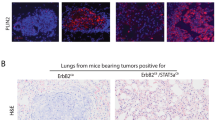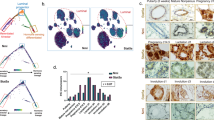Abstract
Physiological apoptosis is induced by a switch from survival to death signalling. Dysregulation of this process is frequently associated with cancer1. A powerful model for this apoptotic switch is mammary gland involution, during which redundant milk-producing epithelial cells undergo apoptosis2. Signal transducer and activator of transcription 3 (Stat3) is an essential mediator of this switch but the mechanism has not yet been defined3. Stat3-dependent cell death during involution can be blocked by activation of Akt/protein kinase B (PKB)4, a downstream effector of the phosphoinositide-3-OH kinase (PI(3)K) pathway5. Here we show that expression of the PI(3)K regulatory subunits p55α and p50α is induced by Stat3 during involution. In the absence of Stat3 in vivo, upregulation of p55α and p50α is abrogated, levels of activated Akt are sustained and apoptosis is prevented. Chromatin immunoprecipitation assays show that Stat3 binds directly to the p55α and p50α promoters in vivo. Overexpression of either p55α or p50α reduces levels of activated Akt. We propose a novel mechanism in which Stat3 regulates apoptosis by inducing expression of distinct PI(3)K regulatory subunits to downregulate PI(3)K-Akt-mediated survival signalling.
This is a preview of subscription content, access via your institution
Access options
Subscribe to this journal
Receive 12 print issues and online access
$209.00 per year
only $17.42 per issue
Buy this article
- Purchase on Springer Link
- Instant access to full article PDF
Prices may be subject to local taxes which are calculated during checkout





Similar content being viewed by others
References
Schulze-Bergkamen, H. & Krammer, P. H. Apoptosis in cancer-implications for therapy. Semin. Oncol. 31, 90–119 (2004).
Kumar, R., Vadlamudi, R. K. & Adam, L. Apoptosis in mammary gland and cancer. Endocr. Relat. Cancer 7, 257–269 (2000).
Chapman, R. S. et al. Suppression of epithelial apoptosis and delayed mammary gland involution in mice with a conditional knockout of Stat3. Genes Dev. 13, 2604–2616 (1999).
Schwertfeger, K. L., Richert, M. M. & Anderson, S. M. Mammary gland involution is delayed by activated Akt in transgenic mice. Mol. Endocrinol. 15, 867–881 (2001).
Franke, T. F. et al. The protein kinase encoded by the Akt proto-oncogene is a target of the PDGF-activated phosphatidylinositol 3-kinase. Cell 2, 727–736 (1995).
Levy, D. E. & Darnell, J. E. Jr. Stats: transcriptional control and biological impact. Nature Rev. Mol. Cell Biol. 3, 651–662 (2002).
Kritikou, E. A. et al. A dual, non-redundant, role for LIF as a regulator of development and STAT3-mediated cell death in mammary gland. Development 130, 3459–3468 (2003).
Yu, H. & Jove, R. The STATs of cancer - new molecular targets come of age. Nature Rev. Cancer 4, 97–105 (2004).
Stambolic, V. et al. Negative regulation of PKB/Akt-dependent cell survival by the tumor suppressor PTEN. Cell 95, 29–39 (1998).
Otsu, M. et al. Characterization of two 85 kd proteins that associate with receptor tyrosine kinases, middle-T/pp60c-src complexes, and PI3-kinase. Cell 65, 91–104 (1991).
Pons, S. et al. The structure and function of p55PIK reveal a new regulatory subunit for phosphatidylinositol 3-kinase. Mol. Cell Biol. 15, 4453–4465 (1995).
Antonetti, D. A., Algenstaedt, P. & Kahn, C. R. Insulin receptor substrate 1 binds two novel splice variants of the regulatory subunit of phosphatidylinositol 3-kinase in muscle and brain. Mol. Cell Biol. 16, 2195–2203 (1996).
Inukai, K. et al. A novel 55-kDa regulatory subunit for phosphatidylinositol 3-kinase structurally similar to p55PIK is generated by alternative splicing of the p85 gene. J. Biol. Chem. 271, 5317–5320 (1996).
Fruman, D. A., Cantley, L. C. & Carpenter, C. L. Structural organization and alternative splicing of the murine phosphoinositide 3-kinase p85 alpha gene. Genomics 37, 113–121 (1996).
Inukai, K. et al. p85 gene generates three isoforms of regulatory subunit for phosphatidylinositol 3-kinase (PI 3-Kinase), p50, p55, and p85, with different PI 3-kinase activity elevating responses to insulin. J. Biol. Chem. 272, 7873–7882 (1997).
Vanhaesebroeck, B., Leevers, S. J., Panayotou, G. & Waterfield, M. D. Phosphoinositide 3-kinases: a conserved family of signal transducers. Trends Biochem. Sci. 22, 267–272 (1997).
Cantley, L. C. The phosphoinositide 3-kinase pathway. Science 296, 1655–1657 (2002).
Ueki, K., Algenstaedt, P., Mauvais-Jarvis, F. & Kahn, C. R. Positive and negative regulation of phosphoinositide 3-kinase-dependent signaling pathways by three different gene products of the p85 regulatory subunit. Mol. Cell Biol. 20, 8035–8046 (2000).
Ueki, K. et al. Molecular balance between the regulatory and catalytic subunits of phosphoinositide 3-kinase regulates cell signaling and survival. Mol. Cell Biol. 22, 965–977 (2002).
Inukai, K. et al. Five isoforms of the phosphatidylinositol 3-kinase regulatory subunit exhibit different associations with receptor tyrosine kinases and their tyrosine phosphorylations. FEBS Lett. 490, 32–38 (2001).
O'Farrell, A. M., Liu, Y., Moore, K. W. & Mui, A. L. IL-10 inhibits macrophage activation and proliferation by distinct signaling mechanisms: evidence for Stat3-dependent and -independent pathways. EMBO J. 16, 1006–1018 (1998).
Leaman, D. W. et al. Roles of JAKs in activation of STATs and stimulation of c-fos gene expression by epidermal growth factor. Mol. Cell Biol. 16, 369–375 (1996).
Niwa, H., Burdon, T., Chambers, I. & Smith, A. Self-renewal of pluripotent embryonic stem cells is mediated via activation of STAT3. Genes Dev. 12, 2048–2060 (1998).
Burdon, T., Smith, A. & Savatier, P. Signalling, cell cycle and pluripotency in embryonic stem cells. Trends Cell Biol. 12, 432–438 (2002).
Hallmann, D. et al. Altered signaling and cell cycle regulation in embryonal stem cells with a disruption of the gene for phosphoinositide 3-kinase regulatory subunit p85. J. Biol. Chem. 278, 5099–5108 (2003).
Kerouz, N. J., Horsch, D., Pons, S. & Kahn, C. R. Differential regulation of insulin receptor substrates-1 and -2 (IRS-1 and IRS-2) and phosphatidylinositol 3-kinase isoforms in liver and muscle of the obese diabetic (ob/ob) mouse. J. Clin. Invest. 100, 3164–3172 (1997).
Torbenson, M. et al. STAT-3 overexpression and p21 up-regulation accompany impaired regeneration of fatty livers. Am. J. Pathol. 161, 155–161 (2002).
Dani, C. et al. Paracrine induction of stem cell renewal by LIF-deficient cells: a new ES cell regulatory pathway. Dev. Biol. 203, 149–162 (1998).
Vanhaesebroeck, B. et al. Distinct PI(3)Ks mediate mitogenic signalling and cell migration in macrophages. Nature Cell Biol. 1, 69–71 (1999).
Davuluri, R. V., Grosse, I. & Zhang, M. Q. Computational identification of promoters and first exons in the human genome. Nature Genet. 4, 412–417 (2001). Erratum in Nature Genet. 3, 459 (2002).
Acknowledgements
This work was supported by BBSRC grant number G18086. A.B. was supported by the Ludwig Institute for Cancer Research and by FIRB 2001 (Italy). We thank P. Came and F. Baxter for providing the TUNEL data, T. Rich and B. Kedjouar for critical reading of the manuscript, D. Vetrie for advice on ChIP assay, and A. Tolkovsky and C. Goemans for help with the adenovirus assays.
Author information
Authors and Affiliations
Corresponding author
Ethics declarations
Competing interests
The authors declare no competing financial interests.
Rights and permissions
About this article
Cite this article
Abell, K., Bilancio, A., Clarkson, R. et al. Stat3-induced apoptosis requires a molecular switch in PI(3)K subunit composition. Nat Cell Biol 7, 392–398 (2005). https://doi.org/10.1038/ncb1242
Received:
Accepted:
Published:
Issue Date:
DOI: https://doi.org/10.1038/ncb1242
This article is cited by
-
O-GlcNAcylation mediates H2O2-induced apoptosis through regulation of STAT3 and FOXO1
Acta Pharmacologica Sinica (2024)
-
Fourteenth Annual ENBDC Workshop: Methods in Mammary Gland Biology and Breast Cancer
Journal of Mammary Gland Biology and Neoplasia (2023)
-
Novel insights for PI3KC3 in mediating lipid accumulation in yellow catfish Pelteobagrus fulvidraco
Fish Physiology and Biochemistry (2022)
-
Morphological, hormonal, and molecular changes in different maternal tissues during lactation and post-lactation
The Journal of Physiological Sciences (2019)
-
cIAP2 Is an Independent Signaling and Survival Factor during Mammary Lactational Involution and Tumorigenesis
Journal of Mammary Gland Biology and Neoplasia (2018)



